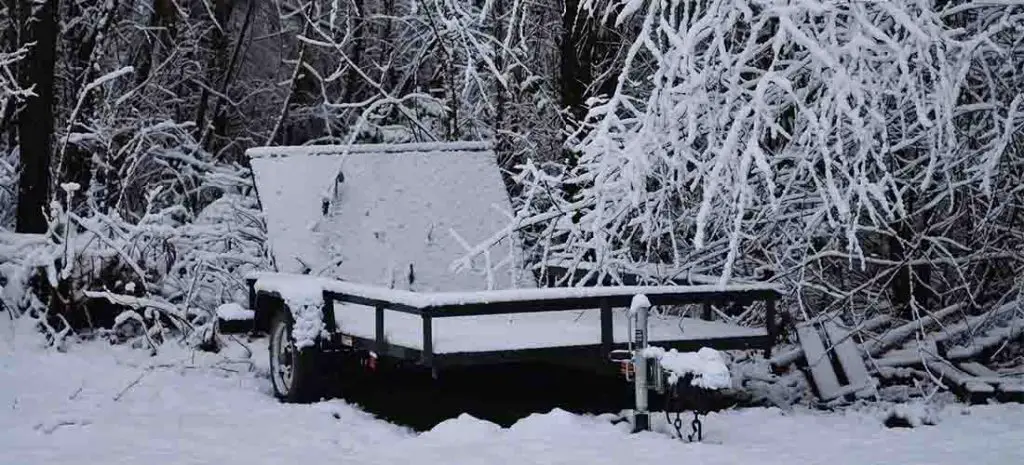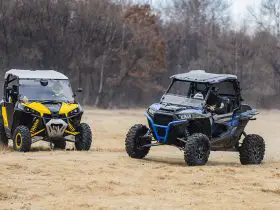The best part of owning a UTV is riding trails, racing across the desert, or climbing the dunes. But, for those of us not lucky enough to live on a ranch or have a riding area at the doorstep, driving our side-by-side to the trail is not an option, especially since their riding on the streets is illegal in most of the states. Fun only starts after we haul our vehicle to the desired destination.
Transporting a UTV is not an overly complicated task, but if not done right, it may cost you a whole day of enjoying the ride. Even worse, improper hauling can endanger your safety and lead to serious damage to your UTV or towing vehicle. Particularly since transporting your vehicle can sometimes mean spending days on the road during an across the country trip to cross up some of the distant riding trails off of your bucket list.
Table of Contents
The Options for Hauling your UTV
SxS owners have many means available when it comes to transporting their four-wheeler. Some toss it up on their pick-up truck, others use different kinds of trailers or Toy Haulers. The choice depends on several factors. First and foremost, the size of UTV, and then your budget, intended use, and personal preference. Each way has its benefits and drawbacks, so think carefully before deciding on one of them.
Is Flat Towing an Option?
Towing a UTV can be done, especially for shorter distances, flat towing your UTV is not recommended. First of all, to do this, your vehicle needs to be street legal and registered with your state’s BMV, which most of UTVs, particularly straight from the factory, are not. Among other things, most of them are equipped with off-road “dirt” tires which are not street legal.
Besides, you don’t want to put unnecessary strain and mileage on your vehicle or your tires. Driving on a pavement with a speed of around 70 Mph will cause your stock tires to burn up and melt. Unlike cars or jeeps, UTVs do not have a tow bar option, so the alignment with the towing vehicle would be all screwed up. Adjusting alignment for towing means that once you reach your destination, you’ll have to readjust your vehicle all over again and repeat the process for a trip back home. Definitely not worth the effort.
Hauling Your UTV in a Truck
Even though they are smaller than cars or jeeps, UTVs still have bigger dimensions than ATVs or motorbikes that we usually see hauled at the back of the pick-up truck. Still some of the models, such as youth side-by-sides and those that don’t exceed 50 inches in width and 90-100 inches in length, can be loaded up on a truck bed and hauled around. If you plan to use this mode of transportation, make sure that the size of the UTV you are thinking of buying fits the size of your truck bed. Consider that you will probably need some extra space on the truck for other machines, various equipment, and supplies.
In case you have a truck that can fit your UTV, there are a few things worth paying attention to. Loading your SxS onto a truck will require a loading ramp. Make sure that the ramp you use can support the weight of your UTV and properly connected to the bed of a truck. Hook it with a tie strap to the hitch on the back of a truck to prevent them from moving during the loading process. It’s clear how damaging and dangerous ramp sliding of a truck can be.
Once you get your vehicle onto a truck be careful not to get to close to the back window since any sudden forward surge during the drive may damage it. Secure your side-by-side in place using ratchet tie-downs or tire bonnets. This is crucial since you’ll probably have to ride with your tailgate open and you don’t want your expensive toy falling out during the transport. If you are worried about your tailgate holding up, you can use attachments known as gate savers which use the hitch on the back of the truck to support the UTV’s tires to spare the tailgate from the extra load.
If you are hell-bent on using your truck for hauling even if your SxS doesn’t fit in the bed, maybe you can try using UTV truck racks. They are attached to the truck bed and UTV sits on top of them. Some longer models even stretch beyond the cabin. Besides enabling you to transport longer UTV models, racks are also convenient because of the space left beneath them. You can use this extras space for storage of equipment and supplies. The drawback is that they are not that cheap and you will also have to use different, longer ramps.

Hauling with Open Trailers
Using open-air utility trailers is the most common way to haul your UTV. There’s a variety of models available on the market and they are convenient, easy to use, practical, and not as expensive as other means of transportation. There are some UTV owners that even use modified boat trailers. The weight and size of a trailer mean that you can tow it when fully-loaded even with the less powerful towing vehicle.
Whichever trailer you use, make sure that it can fit your four-wheeler and support its weight. Depending on a UTV’s dimensions and the weight you may go for trailer with a single or double axle. Loading and securing your vehicle is essential for safe hauling. It’s important, especially with single axle models, that you place your ride properly on the trailer deck and distribute the weight so it doesn’t jeopardize stability. Secure the UTV using four straps with ratchet tie-downs.
The main disadvantage of an open trailer is that it’s, perhaps, not the best choice for long trips. The fact that it is open means that your UTV will be vulnerable to weather elements and rocks and debris flying off the road. Also, if you’re spending the more days on your travel or at the riding trail, the open trailer may be an unsafe way to leave your UTV overnight. Although it’s not that easy to haul and get away wit he vehicle, the trailer’s openness will surely attract thieves. For short trips, though, it’s probably the best way to haul your machine.
Transport in Enclosed Cargo Trailers
More expensive than open-air utility trailers, but cheaper than Toy Haulers, enclosed cargo trailers are not the most popular means of transportation among the UTVers. Still, they have some advantages and deserve a look. Compared to open counterparts, enclosed trailers are a much safer way to haul your machine. They will keep your vehicle safe from weather elements and secure during overnight stays. You will be able to have peace of mind while driving and not think about your UTV’s security. Besides, they are generally larger than open trailers and offer more storage space.
On the minus side there is their limited height. Same as with other means of transportation would have to take into account your UTV’s fit. Only here, unlike loading your UTV on a truck or an open trial, you also have to think about height fit. They also weigh more, meaning you’ll need a more powerful towing vehicle.
Using Toy Haulers
Toy Haulers, mostly because of their size, are popular among UTVers who own larger and longer vehicles. Some toy haulers, such as Genesis Supreme 40-SRSS6 or Gargezilla 4620W can even carry two side-by-sides. Another reason for going with this means of transportation is that it is suitable for longer multiple days drives and provides the perfect accommodation for several days you may spend at one destination. In the long run, it’s a cheaper and more convenient option than renting a motel room or a cabin. It’s basically home on wheels with the extra garage space.
Of course, all these perks mean that Toy Haulers carry a hefty price. Most people find it too pricey, especially after they’ve already splurged on the UTV of choice. In fact, most of Toy Haulers are more expensive than even top of the line UTV’s. Besides, they weigh a lot, especially loaded, so you’ll need a large and powerful vehicle to tow it.

Hauling Safety Tips
- Give your prospect route a test drive, especially if it’s the one you’ll use often. Driving and handling while towing another vehicle is not that simple. Turning angles will change Get to know the corners and road specifics and drive defensively
- Increase the distance between you and the vehicle in front while driving. You are much heavier with another vehicle hooked up in the back so it will take longer to stop
- Trailer, particularly enclosed ones will increase blind spots so be careful when changing lanes
- Strap on a helmet while loading and unloading.
- Always check your straps to see if they are tightened properly. Securing the load is essential for a safe drive
- During longer trips pull over on every hour and use fuel stops to check the gear and your UTV’s security
- Do the research and make sure that your selected means of transportation can handle UTV’s weight and size
- Make sure to bring a spare tire and a jack if you’re using a trailer
- Check the trailer tire pressure before every trip
- If there’s any extra equipment being towed along with the UTV, make sure it’s also properly secured
- Find a parking space with as much space as possible









